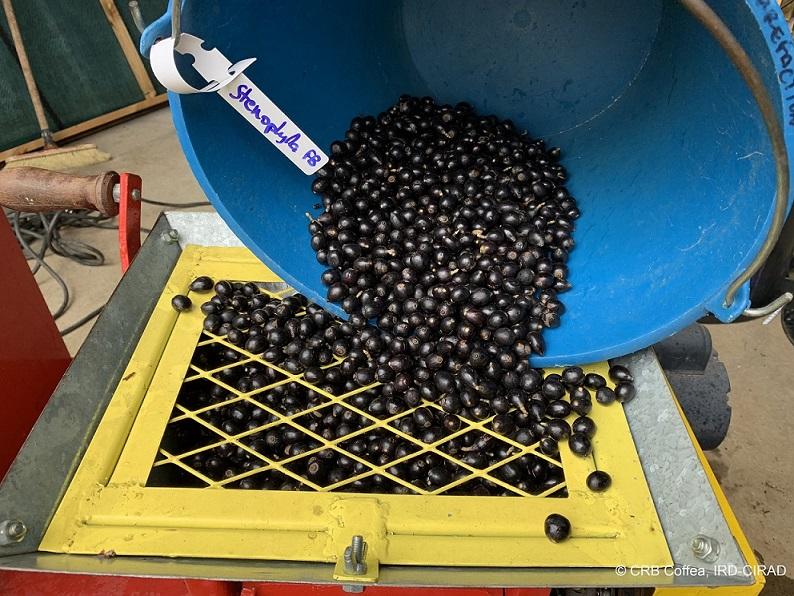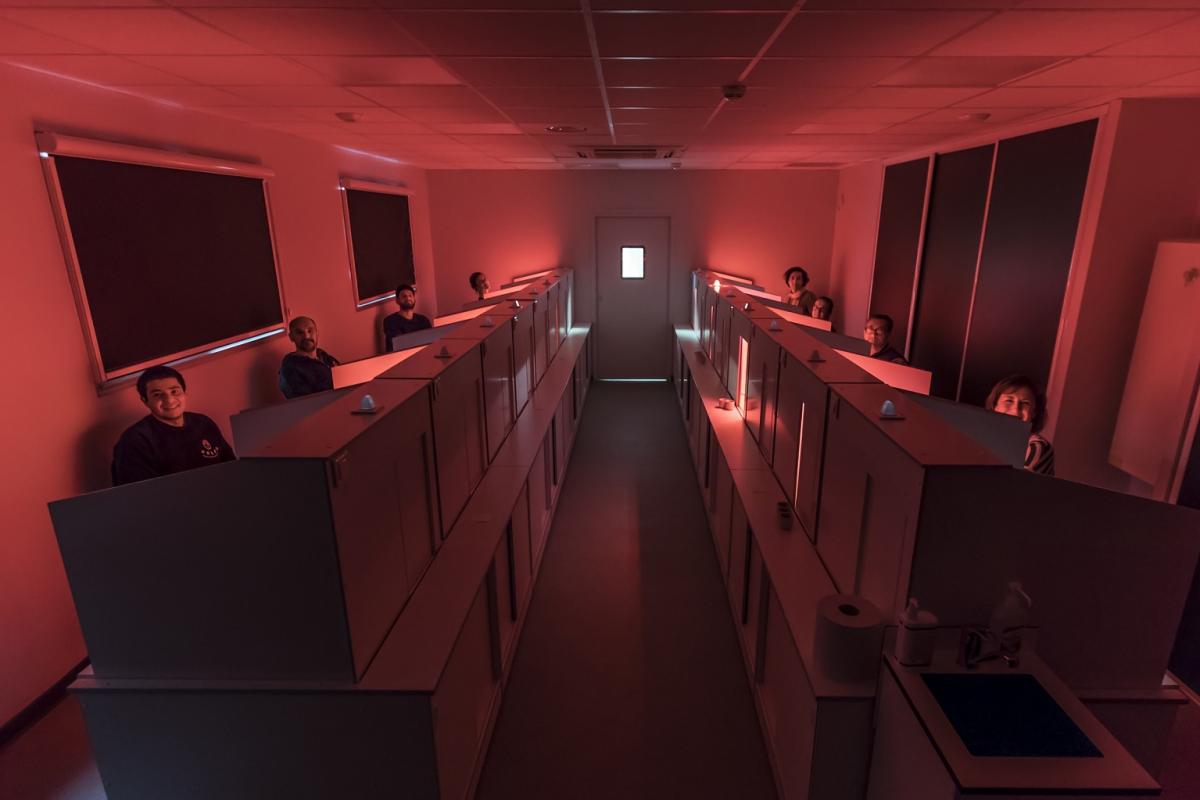Results & impact 10 October 2025
- Home
- Press area
- Press releases
- coffea stenophylla coffee climate change
‘Forgotten’ coffee species could help to futureproof the coffee industry under climate change

Coffea stenophylla is unusual in that it has black cherries. It has now almost entirely died out, and is on the IUCN Red List © Coffea BRC, IRD-CIRAD
In a new paper published today in Nature Plants, scientists from the Royal Botanic Gardens, Kew, the University of Greenwich, CIRAD (the French Agricultural Research Centre for International Development) and Sierra Leone reveal the results of an in-depth study of a ‘rediscovered’ coffee species that has the potential to help futureproof the coffee industry against climate change.
Stenophylla coffee (Coffea stenophylla), a rare wild species from Upper West Africa, has been found to tolerate much warmer temperatures than Arabica coffee (Coffea arabica), the world’s most popular coffee, whilst boasting a superior flavour. These unique qualities mean that stenophylla could soon be grown commercially, but in much warmer places than Arabica. It also has the potential to be used as a breeding resource, to produce new, climate-resilient coffee crops for global consumption. This discovery comes at a crucial time, as up until this point, experts had not identified any robust means of protecting coffee farming from the climate crisis.
Dr Aaron Davis, Head of Coffee Research at RBG Kew, and lead author of the paper, says: “Future-proofing the coffee supply chain to deal with climate change is vital – coffee drives a multibillion dollar global industry, supports the economy of several tropical countries, and provides livelihoods for more than 100 million coffee farmers. To find a coffee species that flourishes at higher temperatures and has an excellent flavour is a once in a lifetime scientific discovery – this species could be essential for the future of high-quality coffee.”
What about the coffee we drink now?
There are 124 species of coffee, but we rely on just two for 99% of our coffee consumption: Arabica and robusta, making up 56% and 43% of global production respectively. Arabica, originating from the highlands of Ethiopia and South Sudan, is a cool-tropical plant with a mean annual temperature requirement of around 19⁰C. It is vulnerable to increasing global temperatures and coffee leaf rust, a fungal disease that has severely impacted coffee plantations in Central and South America. Robusta fares slightly better – the species grows at low elevations across much of wet-tropical Africa, requires a mean annual temperature of around 23⁰C, and is resistant to certain strains of coffee leaf rust. However, robusta falls short in its flavour and is widely regarded as inferior to Arabica, with the majority of its production used for instant coffee.
Lost then found: the ‘forgotten’ coffee species
Until recently (late 2018) stenophylla had not been seen in the wild since 1954. The term ‘forgotten’ is applied to this species because it was once widely farmed in Upper West Africa. Today, its use as a crop species is non-existent, and only a few examples exist in coffee research collections. So, in December 2018, two of the paper’s authors (Dr Davis and Professor Haggar) travelled to Sierra Leone to work with development specialist Daniel Sarmu, to try and locate the species in the wild. They used historical specimens from RBG Kew to provide details of the last known locality of stenophylla coffee. With support of NGO Welthungerhilfe and the Sierra Leone Forestry Department, they visited the main target location, where they found only a single plant of stenophylla coffee. Moving east, they visited another forest area, and after several hours of trekking through dense forest, they finally located a healthy population.
A coffee that can handle rising temperatures
Endemic to Guinea, Sierra Leone and Ivory Coast, stenophylla grows wild in hot-tropical areas at low elevation, only 400 m above sea level. After collecting data for Arabica, robusta, and stenophylla, the paper’s authors set to work to understand their fundamental environmental requirements. They found that stenophylla grows and crops under similar climatic conditions to robusta, but with a higher mean annual temperature requirement of 24.9⁰C (1.9⁰C higher than that of robusta), and a substantial 6.2–6.8⁰C higher than Arabica. Stenophylla coffee is also reported to be drought tolerant, although this attribute requires further research.
Stenophylla: The taste test
There had been no recorded sensory information for stenophylla for 100 years, due to its scarcity in cultivation and rarity in the wild so it was essential for this species to be properly evaluated. Obtaining a small sample from partners in Sierra Leone, stenophylla was assessed by an expert tasting panel at Union Hand-Roasted Coffee in London in the summer of 2020. The panel awarded the coffee a speciality score of 80.25 (based on the protocol of the Specialty Coffee Association) and identified Arabica-like qualities. To reach ‘speciality’ status, a coffee needs a score of 80 points or higher. Jeremy Torz from Union Coffee said, “Arabica is currently our only speciality coffee species, and so this score, particularly from such a small sample, was surprising and remarkable.”
After this initial tasting in London, an additional and much more substantial sample of stenophylla, this time from Ivory Coast, was obtained from the Coffea Biological Resources Center on Reunion Island in the Indian Ocean. The sample was evaluated at CIRAD’s sensorial analysis laboratory in Montpellier by a panel of judges, and then soon afterwards by coffee experts from companies including JDE, Nespresso and Belco. The 15-strong panel blind tested two Arabica samples (one high quality and one low grade), one high-quality robusta sample, and the Ivory Coast stenophylla.
The evaluation revealed that stenophylla has a complex flavour profile, with judges noting its natural sweetness, medium-high acidity, fruitiness, and good body (i.e. its texture; the way it feels in the mouth). Desirable tasting notes included peach, blackcurrant, mandarin, honey, light black tea, jasmine, spice, floral, chocolate, caramel, nuts, and elderflower syrup, as one might find in high-quality Arabica. When asked if the stenophylla sample was an Arabica, 81% of the judges said yes (compared to 98% and 44% for the two Arabica samples, and 7% for the robusta sample). Despite the high ‘Arabica-like’ score for stenophylla, 47% of the judges identified the sample as something new, suggesting a market niche for the rediscovered coffee.
Dr Delphine Mieulet, scientist at CIRAD, who led the tasting says: “These results provide the first credible sensory evaluation for stenophylla coffee, from which we are able to corroborate historical reports of a superior taste. The sensory analysis of stenophylla reveals a complex and unusual flavour profile that the judges unanimously found worthy of interest. For me, as a breeder, this new species is full of hope and allows us to imagine a bright future for quality coffee, despite climate change.”
What’s next?
Coffea stenophylla is classified on the IUCN Red List of Threatened Species as ‘Vulnerable’, so efforts are urgently required to safeguard the future of the species in the wild. Further work is required to fully evaluate its potential as a climate resilient, high-value crop species and breeding resource, including claims of drought tolerance and resistance to coffee leaf rust. This year, the four institutes involved in the paper plan to plant stenophylla seedlings in Sierra Leone and Reunion Island (CIRAD), in order to start assessing its agronomic potential under a range of environmental conditions.
Read more on the RBG Kew's website
Reference
Aaron P. Davis, Delphine Mieulet, Justin Moat, Daniel Sarmu, and Jeremy Haggar. Arabica-like flavour in a heat tolerant wild coffee species. Nature Plants -19 avril 2021
What does James Hoffmann think of this new species ?
About the Royal Botanic Gardens, Kew
The Royal Botanic Gardens, Kew is a world-famous scientific organisation, internationally respected for its outstanding collections as well as its scientific expertise in plant and fungal diversity, conservation and sustainable development in the UK and around the world. Kew Gardens is a major international and a top London visitor attraction. Kew Gardens’ 132 hectares of landscaped gardens, and Wakehurst, Kew’s wild botanic garden in Sussex, attract over 2.5 million visits every year. Kew Gardens was made a UNESCO World Heritage Site in July 2003 and celebrated its 260th anniversary in 2019. Wakehurst is home to Kew's Millennium Seed Bank, the largest wild plant seed bank in the world, as well as over 500 acres of designed landscapes, wild woodlands, ornamental gardens and a nature reserve. The Kew Madagascar Conservation Centre is Kew’s third research centre and only overseas office. RBG Kew receives approximately one third of its funding from Government through the Department for the Environment, Food and Rural Affairs (Defra) and research councils. Further funding needed to support RBG Kew’s vital work comes from donors, membership and commercial activity including ticket sales.
About CIRAD
CIRAD is the French agricultural research and international cooperation organization working for the sustainable development of tropical and Mediterranean regions. It works with its partners to build knowledge and solutions and invent resilient farming systems for a more sustainable, inclusive world. It mobilizes science, innovation and training in order to achieve the Sustainable Development Goals. Its expertise supports the entire range of stakeholders, from producers to public policymakers, to foster biodiversity protection, agroecological transitions, food system sustainability, health (of plants, animals and ecosystems), sustainable development of rural territories, and their resilience to climate change. CIRAD works in some fifty countries on every continent, thanks to the expertise of its 1650 staff members, including 1140 scientists, backed by a global network of some 200 partners. As such, it supports French scientific diplomacy operations.
About the University of Greenwich’s Natural Resources Institute (NRI)
The Natural Resources Institute (NRI), is a specialist research, development and education organisation of the University of Greenwich, UK, with a focus on food, agriculture, environment and sustainable livelihoods. Using an interdisciplinary approach, we undertake research, teaching, training and consultancy to address interrelated global challenges affecting everyone from local farmers and consumers to the UK food industry, to smallholder communities in the developing world. Together with our international partners, we tackle issues including poverty, food and nutrition security, sustainable agriculture, climate change, gender and social equality, responsible production and consumption, exploitation of natural resources and environmental management. NRI’s work addresses the UN Sustainable Development Goals – the globally agreed plan of action to achieve sustainable development for all by 2030 – and is organised through our Research Groups and Development Programmes. NRI’s team is made up of over 100 members of staff including natural and social scientists, technicians, and specialists in project management, administration, communication, finance, IT and other fields.




























